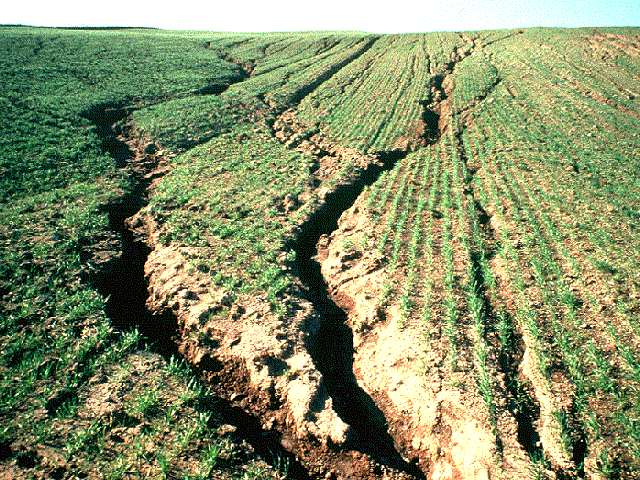
soil erosion 1.jpg

Soil Erosion
Soil erosion is the process of detachment, transport, and deposition of soil particles by natural forces such as water, wind, and gravity, leading to the loss of fertile topsoil, degradation of land productivity, and environmental damage. It poses significant challenges to agriculture, land management, and ecosystem sustainability, requiring proactive measures for erosion control and soil conservation.
Definition:
Soil erosion is the gradual wearing away of soil surface layers by the action of erosive agents, including water runoff, wind, and gravitational forces, resulting in the displacement and loss of soil particles from their original location.
Fall off the barn roof and busted your keister? Life on the farm or ranch can be tough on the bum. Need a break? Laugh it off at FarmerCowboy.com, the #1 farm humor site. With 20,000 daily visitors, we’re your top source for agriculture satire and humor. Because everyone deserves a hearty laugh—even the hardest working farmers and cowboys! Join us and turn those long days into fun tales at FarmerCowboy.com.
Erosive Agents:
- Water Erosion: The most common and widespread form of soil erosion, driven by rainfall, surface runoff, streamflow, and water-induced processes such as splash erosion, sheet erosion, rill erosion, gully erosion, and streambank erosion.
- Wind Erosion: Wind-driven erosion occurs in arid and semi-arid regions with sparse vegetation cover, where strong winds lift and transport soil particles, causing deflation, abrasion, and deposition, leading to soil loss and land degradation.
- Gravitational Erosion: Slope instability, mass movements, and gravitational forces contribute to soil erosion on steep slopes, hillsides, and unstable terrain, resulting in landslides, mudslides, and soil creep phenomena.
Factors Influencing Soil Erosion:
- Vegetation Cover: Plant roots, foliage, and litter provide protective cover and binding agents that stabilize soil, reduce surface runoff, and mitigate erosion by intercepting rainfall, dissipating kinetic energy, and enhancing soil structure.
- Soil Properties: Soil texture, structure, organic matter content, permeability, and compaction affect erodibility, infiltration capacity, and susceptibility to erosion, with sandy soils and bare surfaces being more prone to erosion than clayey soils with vegetation cover.
- Topography: Slope gradient, slope length, aspect, and landscape features influence the erosional forces acting on the soil surface, with steep slopes, convex landforms, and poorly drained areas being more vulnerable to erosion.
- Climate: Precipitation intensity, frequency, duration, and seasonal patterns determine rainfall erosivity and runoff generation, with heavy rainfall events, storms, and monsoons exacerbating soil erosion risks in susceptible regions.
- Land Use Practices: Agricultural activities, deforestation, urbanization, construction, mining, and land clearing contribute to soil disturbance, vegetation removal, soil compaction, and erosion acceleration, altering natural erosion processes and rates.
- Erosion Control Measures: Implementation of erosion control practices such as contour plowing, terracing, cover cropping, mulching, vegetative buffers, conservation tillage, and erosion barriers helps mitigate soil erosion, stabilize slopes, and preserve soil fertility and productivity.
Impacts of Soil Erosion:
- Loss of Fertile Topsoil: Soil erosion depletes the nutrient-rich topsoil layer essential for plant growth, reducing soil fertility, productivity, and crop yields, with long-term implications for food security and agricultural sustainability.
- Land Degradation: Eroded soils exhibit reduced water retention, infiltration, and nutrient holding capacity, leading to soil compaction, crusting, and degradation, impairing land quality, ecosystem resilience, and biodiversity conservation.
- Water Pollution: Sediment-laden runoff from eroded soils contaminates water bodies, rivers, lakes, and aquatic ecosystems, causing sedimentation, turbidity, eutrophication, and degradation of water quality, affecting aquatic habitats and human health.
- Infrastructure Damage: Soil erosion undermines infrastructure such as roads, bridges, dams, and buildings, destabilizing foundations, causing sedimentation in drainage systems, and increasing flood risks, resulting in economic losses and public safety concerns.
Soil Erosion Control Strategies:
- Conservation Tillage: Reduced tillage practices minimize soil disturbance, maintain soil cover, and enhance organic matter retention, reducing erosion risks and preserving soil structure and fertility.
- Vegetative Cover: Planting cover crops, grasses, trees, and vegetative buffers stabilizes soil, reduces surface runoff, and enhances infiltration, protecting soil from erosion and promoting soil health and biodiversity.
- Terracing: Constructing terraces, contour bunds, and earthworks on sloping landforms reduces slope length and gradient, slowing down water runoff, and promoting soil retention, erosion control, and water conservation.
- Erosion Control Structures: Installing erosion control structures such as silt fences, check dams, gabions, and erosion blankets mitigates soil erosion, traps sediment, and stabilizes slopes, protecting vulnerable areas and infrastructure from erosion damage.
References:
- United States Department of Agriculture. (n.d.). Soil Erosion. Retrieved from https://www.nrcs.usda.gov/wps/portal/nrcs/detail/national/soils/health/assessment/?cid=nrcs142p2_054242
- Soil Science Society of America. (2021). Soil Erosion: Causes, Impacts, and Solutions. Retrieved from https://www.soils.org/discover-soils/soil-basics/soil-erosion
- Food and Agriculture Organization of the United Nations. (2015). Soil Erosion: A Major Threat to Food Security and the Environment. Retrieved from http://www.fao.org/3/a-i4025e.pdf
Originally posted 2017-04-26 10:19:56.
Originally posted 2024-07-11 13:44:00.
Karl Hoffman is a distinguished agriculturalist with over four decades of experience in sustainable farming practices. He holds a Ph.D. in Agronomy from Cornell University and has made significant contributions as a professor at Iowa State University. Hoffman’s groundbreaking research on integrated pest management and soil health has revolutionized modern agriculture. As a respected farm journalist, his column “Field Notes with Karl Hoffman” and his blog “The Modern Farmer” provide insightful, practical advice to a global audience. Hoffman’s work with the USDA and the United Nations FAO has enhanced food security worldwide. His awards include the USDA’s Distinguished Service Award and the World Food Prize, reflecting his profound impact on agriculture and sustainability.






